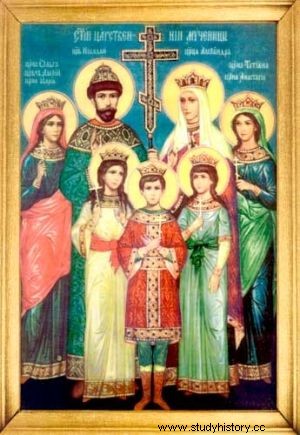The Russian proverb says that when a tsar catches a cold, all of Russia coughs. And no wonder. After all, for the Russians it was none other than their own state God.
At the turn of the Middle Ages and the early modern era, Polish kings were afraid of nothing more than the Russian tsars being awarded the royal title. Stories of Habsburg spies sneaking through Poland to Moscow to hand over the crown to the eastern self-lord kept reappearing.
However, the fears were completely unfounded. The tsars never dreamed of a crown. When in 1489 Ivan III received a proposal to confer the royal title from Emperor Frederick III of Habsburg, he rejected it, saying that he was chosen by God. And that it doesn't need any additional confirmation for that.
You admonish us against God

Tsar Nicholas II with the Holy Family. So… my own family.
Not only that, already in his time, the rulers of Russia were genealogically descended from the Roman emperors in a straight line. This was to confirm that sanctified blood flows in their veins. Ivan IV wrote to the King of Sweden:"We come from Augustus the Emperor, and you admonish us against God." Later, the hereditary relationship of the Russian monarchs with Augustus was emphasized during the coronation of Peter II.
The sanctification of power distinguished Russia from other countries. With its use, the tsars provided their governments with special legitimacy. This idea developed and deepened, thanks to which the tsar gained a special charism, becoming the so-called living icon of Christ.
Saint on the throne
Cara was called "Sun of Justice" . It was a term heretofore reserved for Christ and repeatedly appearing in liturgical texts.
Already in the 1663 letter of the Eastern patriarchs to Alexei Mikhailovich, allegiance to the tsar was recognized as a religious requirement. It was explained that the tsar was called by the name of Christ, so one cannot be a Christian without being a faithful subject.

The coronation of Vasyl III as Tsar. It is worth paying attention to the halos…
The tsar also gradually took over the rights of the patriarch - that is, the head of the church in the east equal to the pope. Tsar Alexius in 1646 ordered his subjects to observe the fasts, in 1647 forbade the monks of the Solovetsky monastery to possess alcohol, and in 1648 he ordered all pagan games and superstitions to be eradicated.
Earth Savior

Christ as Tsar. Or rather the tsar as Christ?
Over time, the nickname "saint" was officially added to many of the tsar's expressions . The ruler came to be called "Earthly Savior" and "Earthly God" . His images were adored, and the date of the tsar's birthday and his coronation were celebrated in churches with great devotion.
The common people worshiped the tsar as a saint and hung his images in the house next to the icons of saints. Moreover, the sacralization was manifested in the portraits of the tsars themselves, which resemble the icons of saints. The Tsar, through his powers - power, the right to judge and decide - became another God for the Russians.
The religious dimension of power also had an impact on legislation - for example, in the 16th century, the subjects were obliged to report criticism of the tsar under penalty of death . And no wonder. After all, you cannot blaspheme against God.
